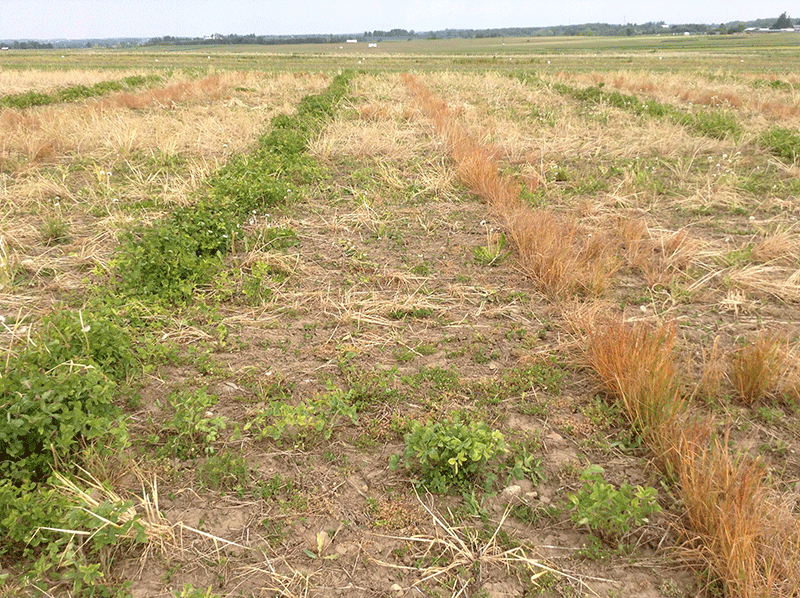Fall burndown
TIPS FOR A WEED FREE 2017
“BE READY TO pounce.” That’s the advice of Mike Cowbrough, weed management lead at the Ontario Ministry of Agriculture, Food and Rural Affairs, on fitting in a fall application of herbicide after corn.
PHOTO: A SPRING APPLICATION OF GLYPHOSATE.

“I’ve never had anyone regret doing it,” Cowbrough says. “A high percentage of farmers do it after cereals, that’s a long-established practice, but people need to try to be aggressive after corn. Keep a close eye on the 14-day forecast, figure out when you can get good uptake in the coming 72 hours, and then do it. Many years, corn harvest drags into December and January so there is no opportunity, but if there is a mild fall/winter, then be ready to pounce.”
Steven Johns, sales agronomist at Syngenta Canada, agrees wholeheartedly. “Fall burndowns applied late in the year for weeds such as dandelions will be extremely effective even when applied after grain corn harvest,” he says. “This is especially important for growers who no-till, strip till, or use some form of vertical tillage. Leaving these dandelions for spring burndowns is a mistake, because control of dandelions in the spring can be quite difficult due to the size of the weeds, cold temperatures, and time constraints.”
PERENNIAL PROBLEMS
In general, Johns believes many more producers could benefit from perennial weed control in the fall. He sees it as “the golden opportunity” to dramatically reduce problematic perennials such as dandelions, tufted vetch, perennial sowthistle, field bindweed, Canada Thistle, and many others. Fall herbicide applications offer far superior perennial control compared to spring applications, he says, because in the fall, these weeds are storing photosynthates and sugars in their growing root systems as reserves for the coming spring. “So, fall applications give excellent control as the herbicides move into these extensive root systems and the weeds have no chance,” he notes.
Cowbrough points to research done decades ago showing that fall burndown provides 10 to 20 per cent better effectiveness for perennial weed control compared to the spring. “The visual control in the fall sometimes isn’t that spectacular, and things will look mediocre,” he notes. “You can wonder if it’s worthwhile doing, but the proof will come in the spring. I’m a big fan of fall weed control for perennial weeds. After cereals which are harvested in July and August, definitely go in and knock down perennial weed populations in mid-September and October.”
Johns reminds us, however, that the ‘sweet spot’ for perennial weed control after wheat is prior to a killing frost. “Some perennials such as milkweed and bindweed are not very frost tolerant, which means that it’s important to apply herbicides before we experience temperatures much below freezing,” he explains.
BEFORE WINTER WHEAT
Both Cowbrough and Johns also recommend doing a fall postharvest application of herbicide after soybeans and dry beans as a great way to clean up the fields prior to planting winter wheat. “As well as perennials, you’ll kill winter annual weeds like chickweed,” Johns says. “It just never seems to work out well when we try to get chickweed in the spring since it is almost mature and well into — or past — flowering by the time we get there with a herbicide.”
Cowbrough adds that fall control is an absolute must for bi-annuals such as burdock, and for wild carrot as well.
“The window is small after soybeans and before planting winter wheat and it’s certainly hard to fit it in, but it’s worth it,” he says. “I’ve seen farmers do an application after soybeans come off to control dandelions and then plant winter wheat and leave a test strip without herbicide for comparison, and in the spring, you can see the dandelions just everywhere in the test strip. I know there’s a temptation with the weather turning to just get the wheat in the ground, and it’s a tough window — but do try.”
Cowbrough mentions another situation where a fall burndown is important. “If you have clover or other perennial cover crops, you also want to kill them in the fall,” he says. “Then you’re in a position where you can just plant in the spring. And with rare weed species like smooth or clammy ground cherries, you’ll never get rid of it, but at least fall applications make it manageable. A fall burndown really provides the only meaningful control.”
Lastly, Johns reminds us that with the ongoing infestation of glyphosate-resistant fleabane across Ontario, it’s more important than ever to use fall weed control whenever possible to eliminate this weed when it’s a small rosette. “If you let them overwinter, you risk having them get too large to control in the spring,” he notes. •






















